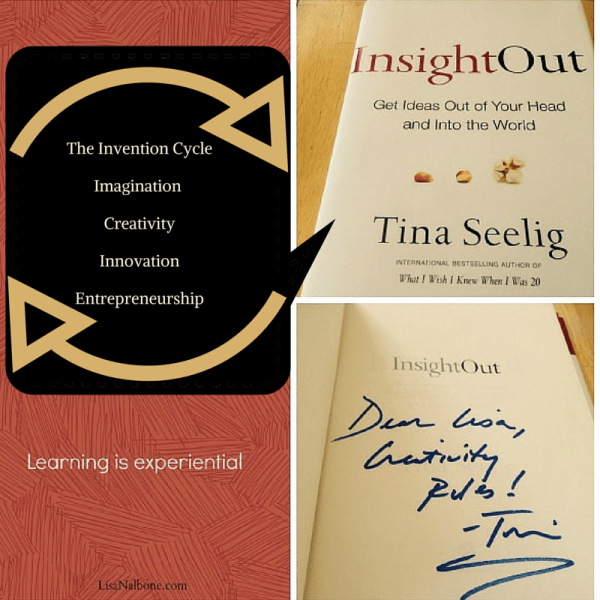Have you ever attended an author talk as part of a book launch?
The energy and excitement is palpable as you are experiencing the reality of someone getting their ideas out of their head and into the world.
Lucky me, I got to head to Palo Alto a few weeks ago to a Kepler’s Book speaker series and listen to and meet Tina Seelig who was launching her latest book InsightOut.
If the book is excellent, the author is an enthusiastic speaker, the audience asks provocative questions, and there are lovely refreshments to support conversation and connection after the talk, the energy and inspiration multiply.
Book Review:Insight Out Get Ideas by Tina Seelig
Tina Seelig, a professor at Stanford University, also wrote What I Wish I Knew When I Was 20 and InGenious: A Crash Course on Creativity. Building on the ideas in her previous books, Seelig defines and clarifies terminology in order to articulate a process she calls the Invention Cycle that can be replicated, practiced and taught. Likewise, you can look at the invention cycle and think about how you can use it for yourself and your children. Seelig’s writing is very personable and she uses a wide variety of examples that can be adapted to other situations. She brings her work from the classroom with grad students, experience from interactions and research in Silicon Valley and around the world, and personal experience together to define an invention cycle and the attitudes and actions necessary to use and teach a process of how we can get our ideas out of our heads and into the world.
I loved the quote from her department at Stanford that she refers to in the letter to readers:
Entrepreneurs do much more than imaginable with much less than seems possible.
from page xii-xiii
As this message communicates, entrepreneurship isn’t just about starting companies. It’s about starting anything! Entrepreneurship involves building the knowledge, skills, and attitudes needed to see problems as opportunities and to leverage resources to bring ideas to fruition. This is just as relevant to those who are starting a rock band or planning at rip around the world as it is to those who are launching a company. The book presents a framework for bringing your ideas to life-whatever those ideas might be.
Yes, or any creative mom!
Or engaged, active person!
As an unschooler and a K-12 educator, many of the lessons Seelig describes are similar to activities I used in my classroom or with groups of home schoolers. I lacked the overarching definition of the Invention Cycle to explain to students and parents what I was aiming for. Her examples from the classroom and her interviews are very broad and show how each of the concepts can be applied in different settings. Most examples are related to business but can be extrapolated to working with younger students, your children, or yourself. Each chapter ends with a project to practice putting the concept into action.
Certainly we should be helping our children learn these attitudes and actions long before they hit grad school.
When questioned during the talk, Tina said she hoped her book and work would help K-12 educators more easily incorporate the Invention Cycle in their classrooms and help make the shift in education that we need. More than a single lesson,or one time unit, using the Invention Cycle as a basis, we can give students the vocabulary, skills, mindsets and practice for how to approach solving problems and creating opportunities for the rest of their lives.
From pages 185-6
“ As described in previous chapters, there is an effective pathway through this process, from inspiration to implementation, with a requisite set of attitudes and actions:
imagination requires acitve engagement and the ability to envision alternatives
creativity requires motivation and experimentation to address challenges
innovation requires focusing and reframing to generate unique solutions
entrepreneurship requires persistence and the ability to inspire others
It is important to keep in mind that your attitudes are impotent unless you develop behaviors that bring those thoughts to fruition; and your actions are doomed to fail unless they are paired with the proper mind-set. By braiding together your attitudes and actions, you prepare yourself to do much more than is imaginable with much less than seems possible, not matter your objective.”
Read InsightOut and start using the invention cycle to help you and your kids get your ideas into the world.
Over to you:
What ideas are you trying to get out of your head and into the world?
What process do you use to go from imagination to implementation?
How do you define the words: imagination, creativity,innovation and entrepreneurship?
